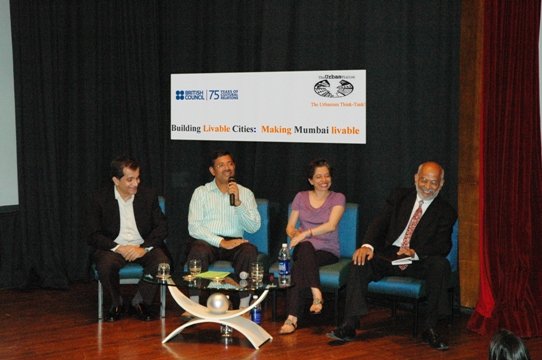Date: Monday, August 3, 2009
Time: 6:15pm – 8:00pm
Location: British Council , Mumbai
How to make Mumbai a better place to live was the theme the discussion that was organised by the The Urban Vision in association with the British Council in Mumbai . The forum focused on the central idea of shaping and reviving the public realm – the streets, the gardens, public squares as a way of improving the city. A multidisciplinary group of experts and leaders including leading architect Dhiru Thadani ; the city’s additional Municipal Commissioner R.A.Rajeev ; Real estate Tycoon Surendra Hiranandani ; Neera Punj of Citispace discussed the city’s present problems and ideas for improving the city’s quality of life.
The discussion started with a presentation of a “Vision plan: Making Mumbai a better place to live” by world-renowned Urban Planner and Architect, Dhiru Thadani who is also the charter member of the influential Congress of New Urbanism. Mr. Thadani presented a 10-point plan to revive Mumbai , “We desperately need to focus on reviving Mumbai’s public spaces. For the most part it is the well-defined public realm – public spaces defined by the buildings which front them and peopled by a vibrant street life that makes a city memorable” he said.
Neera Punj , Convener of civic action group Citispace spoke about the critical need for Mumbai city to increase its green cover from the current 0.03 acres per 1000 persons “”Mumbai needs more open spaces. But we need to ensure that these gardens are open to the public.”
Leading Developer Surendra Hiranandani defined a livable city as having communities that had appropriate human scale architecture, mixed use zones with shop and houses, and a compact urban fabric of blocks, streets and squares. “A livable city has great walkable streets, grand public gardens and squares; and is full of outdoor cafes and restaurants.” He also suggested that “Mumbai needs to reduce auto dependence and look at banning private cars and focus on mass transit”.
R.A Rajeev, Additional Municipal Commissioner, City of Mumbai showcased the results of the landmark program of reviving the open spaces and gardens that he spearheaded in the city over the last year. He also outlined some of the challenges and said “There was a lot of opposition initially towards investment on reviving our public spaces and gardens as most people believed that we should only address issues like affordable housing; but today the response is positive. Many of the citizens of communities, including many slum localities, that were part of the program were extremely happy with the outcome.” He also mentioned the need for citizens to appreciate the larger good of these projects and abstain from the NIMBY’s (Not in my back-yard) Syndrome. He announced that Mumbai city is considering a Non-motorized transit strategy and might embark on development of cycle paths in the city.
Prathima Manohar, Founder, the Urban Vision said “The idea of livable cities must be at the forefront of any strategy or vision to revive our urban centers. Even basic strategies like making our streets walkable; reviving and creating parks and public spaces can contribute largely towards improving the quality of life for all the city’s people. A focus on public realm or placemaking also encourages social interaction and wakability thereby ensuring social and environmental sustainability”. Ms .Manohar also spoke about the need to continue and carry these deliberations forward to larger stakeholder community

